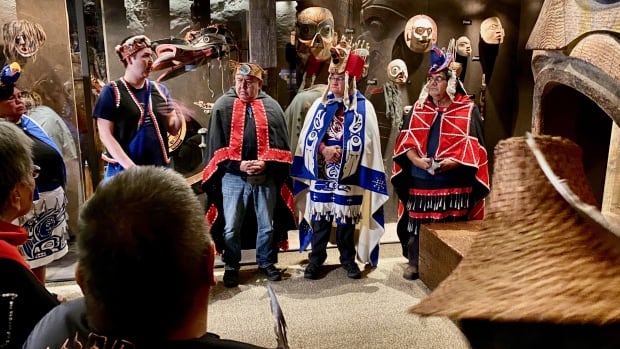Two world-class museums are returning poles to two First Nations in the coming days as North America continues to grapple with its history of removing important Indigenous items and putting them on display.
The Royal B.C. Museum in Victoria, B.C., has agreed to return a totem pole to the Nuxalk Nation, which filed a lawsuit against the museum a year ago for not returning it when its leaders asked for it in 2019.
The artifact was once an entrance pole at the Snuxyaltwa family’s longhouse in Talleomy (South Bentinck) before Nuxalk members relocated to Bella Coola to evade the smallpox epidemic in the early 1900s.
The pole ended up in the Royal B.C. Museum, where it was on display in the Totem Hall on the museum’s third floor for many years.
Walls from the third floor of the museum will have to be removed to get the pole out, according to Janet Hanuse, vice-president of engagement and DRIPA (Declaration on the Rights of Indigenous Peoples Act) Implementation for the museum.
The museum will pay for the cost of removal and transport, Hanuse added. It will begin its journey home on Feb. 13.
“The repatriation of cultural property is an important way of acknowledging and reconciling the unjust treatment First Nations people have endured since contact,” Nuxalk Nation elected chief councillor Samuel Schooner said in an emailed statement.
“Thousands of Nuxalk objects are housed in museums and private collections around the world, and it’s time they all made their way home. This example illustrates the urgent need for funding to create our own museum, a place where we, as Nuxalkmc, can reconnect with the shared treasures of our past.”
At the same time, the Peabody Museum at Harvard University has signed an agreement to ship a house post to the Gitxaala Nation at the end of the month.
It has been housed at the Peabody Museum at Harvard University — on the other side of the continent — since 1917.
The post left its home when it was purchased by a fishing company in 1885.
The museum says it was contacted by the Gitxaala Nation in 2021 as part of an ongoing repatriation project.
In a notice to members posted on its website, the Gitxaala Nation said the post would begin its journey to Prince Rupert at the end of January and expects it will arrive sometime in March.
The nation says it will be on exhibit at the Museum of Northern B.C. in Prince Rupert until a museum in Lax Klan, the village of Gitxaala, is built.
“Working with communities to implement the culturally-responsive care at the museum is fundamental to our commitment to ethical stewardship,” museum director Jane Pickering said in a statement.
“In some cases, ethical stewardship can only truly be achieved by returning a cultural item to its community of origin.”
The Native American Graves Protection and Repatriation Act, an American law passed in 1990, requires institutions that receive federal funding to return Indigenous items and human remains to First Nations, often referred to as Indian tribes in the U.S.
In 2021, the B.C. Museums Association called on Canadian institutions to do the same.
Elroy White, a member of the Heiltsuk Nation and an archaeologist on the Central Coast, said repatriation looks different for each First Nation and each item that’s being returned.
He was involved with the repatriation of several items to the Heiltsuk Nation in recent years. White said there was a lot of work involved as far as data collection, and at times, it was emotional.
“It’s new to us, and we didn’t know how to react to it,” he said.
The return of cultural and ancestral items to First Nations is important, White said, because that’s where they belong.
“Even though they may have educated people worldwide, it wasn’t the intent of those cultural objects.”


